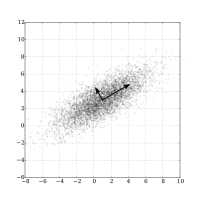
Photo from wikipedia
This paper explains the mathematical foundations of a method for modelling semi-rigid unions. The unions are modelled using rotational rather than linear springs. A nonlinear second-order analysis is required, which… Click to show full abstract
This paper explains the mathematical foundations of a method for modelling semi-rigid unions. The unions are modelled using rotational rather than linear springs. A nonlinear second-order analysis is required, which includes both the effects of the flexibility of the connections as well as the geometrical nonlinearity of the elements. The first task in the implementation of a 2D Beam element with semi-rigid unions in a nonlinear finite element method (FEM) is to define the vector of internal forces and the tangent stiffness matrix. After defining the formula for this vector and matrix in the context of a semi-rigid steel frame, an iterative adjustment of the springs is proposed. This setting allows a moment–rotation relationship for some given load parameters, dimensions, and unions. Modelling semi-rigid connections is performed using Frye and Morris’ polynomial model. The polynomial model has been used for type-4 semi-rigid joints (end plates without column stiffeners), which are typically semi-rigid with moderate structural complexity and intermediate stiffness characteristics. For each step in a non-linear analysis required to adjust the matrix of tangent stiffness, an additional adjustment of the springs with their own iterative process subsumed in the overall process is required. Loops are used in the proposed computational technique. Other types of connections, dimensions, and other parameters can be used with this method. Several examples are shown in a correlated analysis to demonstrate the efficacy of the design process for semi-rigid joints, and this is the work’s application content. It is demonstrated that using the mathematical method presented in this paper, semi-rigid connections may be implemented in the designs while the stiffness of the connection is verified.
Journal Title: Entropy
Year Published: 2022
Link to full text (if available)
Share on Social Media: Sign Up to like & get
recommendations!